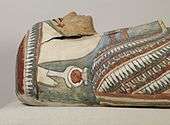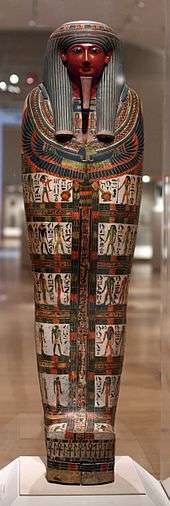Cartonnage
Cartonnage is a type of material used in ancient Egyptian funerary masks from the First Intermediate Period to the Roman era. It was made of layers of linen or papyrus covered with plaster. Some of the Fayum mummy portraits are also painted on panels made of cartonnage.[2]

Technique

In a technique similar to papier-mâché, scraps of linen or papyrus were stuck together with plaster or resin and used to make mummy cases and masks.[3] It could be molded to the shape of the body, forming a type of shell. After the material dried it could be painted or gilded. The shell could be decorated with geometric shapes, deities, and inscriptions. During the Ptolemaic era, the single shell method was altered to include four to six pieces of cartonnage. There would generally be a mask, pectoral, apron, and foot casing. In certain instances there were two additional pieces used to cover the ribcage and stomach.[4]
Materials
The materials used to produce cartonnage changed over time. In the Middle Kingdom it was common to use plastered linen, during the Third Intermediate Period, linen and stucco, during the Ptolemaic period, old papyrus scrolls and during the Roman period, thicker fibrous materials.[5]
Reusing papyrus that was considered waste was a common practice during the Ptolemaic period. Many discarded documents from the government and archives were used for this purpose.[4]
Archeological significance
The preparation of cartonnage preserved the sections of papyrus; therefore, it is a prominent source of well-preserved manuscript sections.[5] In 1993, the city of Helsinki received fourteen fragments of cartonnages from the Egyptian Museum of Berlin. Conservators were tasked with preserving the cartonnages and publishing all Greek papyrus texts derived from them.[6]
References
- "Mummy and Painted Cartonnage of an Unknown Woman". The Walters Art Museum.
- New clues illuminate mysteries of ancient Egyptian portraits - Same artist painted several lifelike paintings buried with mummies by BRUCE BOWER, published by "Society for Science & the Public" on February 14, 2016
- Hayman, written by James Putnam; photographed by Peter (2004). Mummy (Rev. ed.). New York, NY: DK Pub. p. 70. ISBN 0756607078.
- "Cartonnage". Retrieved 29 November 2012.
- "Burial customs:cartonnages". Retrieved 29 November 2012.
- "Cartonnage Papyri". Retrieved 29 November 2012.
External links
- The Walters Art Museum – Mummies and Cartonnage
- Video – Mummy Cartonnage Conservation
- Google Art Project
- Shaw, Ian; and Nicholson, Paul. The Dictionary of Ancient Egypt. p. 61. The British Museum Press, 1995.
- Digital Egypt, fuller history